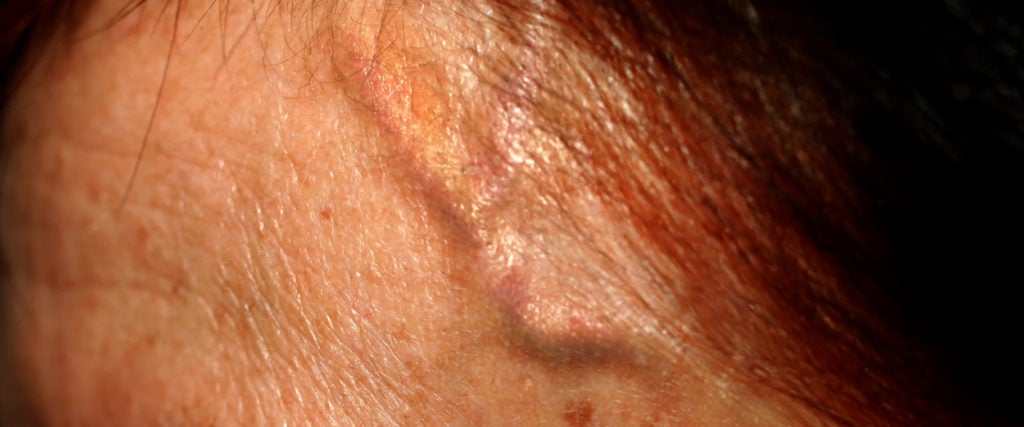If you and I ever meet in person, dear reader, one of the first things you’ll notice about me is the giant, throbbing blue vein that runs down my forehead. For the most part, I’ve grown accustomed to the giant “Y” shape that prevents me from having any semblance of a poker face and earned me the nickname “Flux” (as in “Flux Capacitor”) in high school. Still, though, there are times when I am acutely aware of it, especially when I meet new people and worry they’ll think I’m either furious or constipated.
Surely, in the vast world of skincare and plastic surgery, there must be some way to dial the ol’ Flux Capacitor down from 1.21 gigawatts, right? Not only does a Google search reveal multiple surgical options for “bulging forehead vein removal,” but you can find many other people in the same boat — mostly, guys feeling self-conscious about their raging dome.
By all appearances, then, it seems all I need to do is find a plastic surgeon to schedule a quick, minimally invasive electrosurgery. I’ll be on my way, throb-free for good. Right?
Not so fast, says Alex Sobel, a cosmetic surgeon in Bellevue, Washington, and former president of the American Board of Facial Cosmetic Surgery.
“Let me take a step back to say that this isn’t really a thing to begin with,” Sobel tells me. “It’s just not a thing, though it’ll certainly seem that way in the organic search world [and] marketing sphere, because it’s a question. And when there’s a question, there’s a great marketing opportunity, and sometimes the marketing opportunity leads to a procedure.”
In other words, search engine optimization gave us the burgeoning world of forehead vein surgery. People created content to meet the search demand brought about by forehead-veined people like myself whimsically wondering if it’s possible to fix it. But these search results, Sobel says, are “either dangerous misinformation or just a benign instance of uninformed ghostwriters copying what they’ve seen on other websites.”
The first thing to know is that the veins are chill. They’re not hurting you. Sure, “the veins can be ugly, and sometimes they pop up because of pregnancy or cardiovascular upheavals,” Sobel says. But for the most part, they are neither a sign of a serious health issue nor a threat to your health. (He cautions that if a forehead vein is accompanied by head pain, chest pain, dizziness or eye strain, then you should talk to a healthcare professional.)
What causes big ol’ forehead throbbers like mine? Sobel says it’s simply the case of genetics — “a combination of people whose veins are likely to dilate or maybe have some venous insufficiency, with having thinner skin or less subcutaneous fat,” he explains, adding that it’s a common genetic combination.
Sobel’s bottom line? Learn to love it. Any procedure to get rid of the vein is simply too dangerous or difficult to outweigh the potential risks, he says. The slightest wrong move during the procedure could leave you “looking like you have permanent Botox on one side of your forehead. Material could end up in the brain or go into the back of the orbital or cavernous sinus area very quickly.” Sobel says doctors “try to avoid these veins” when injecting stuff into the face, because there’s a “risk of interfering with retinal [eye] veins and causing blindness.”
Sobel compares veins to the mythical Hydra, a serpent whose many heads grow back when one is severed. Patients who undergo forehead-vein treatment should be prepared for the thing to simply respawn, potentially even more obvious than before.
All that said, there is hope for your Flux Capacitors. There are “a few, very select cases” where surgery would be the right move, Sobel says, as long as everyone is clear about the risks involved.
For the rest of us, there are some less invasive ways to treat it — like getting fat injected into your head. “Again, many of these veins appear because people either have thin skin or not much subcutaneous fat. So injecting some micronized fat carefully around the area can help conceal the vein, which is probably my favorite way of doing it,” Sobel explains. “For those with paper-thin skin, they could see a dermatologist about treating the skin itself to help diminish the appearance.”
Of course, neither of those options are going to make a “knockout difference,” Sobel says, “but if you can mitigate some of those traits that are making the vein more obvious, that might give the patient enough comfort that people aren’t staring at them all the time — and that’s really the end point. We don’t need to get rid of, fix or cure everything. We just want to support the patient’s self image.”

